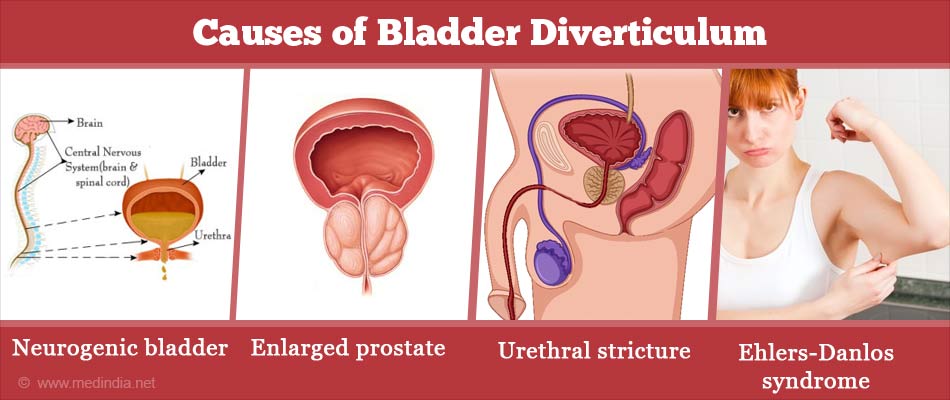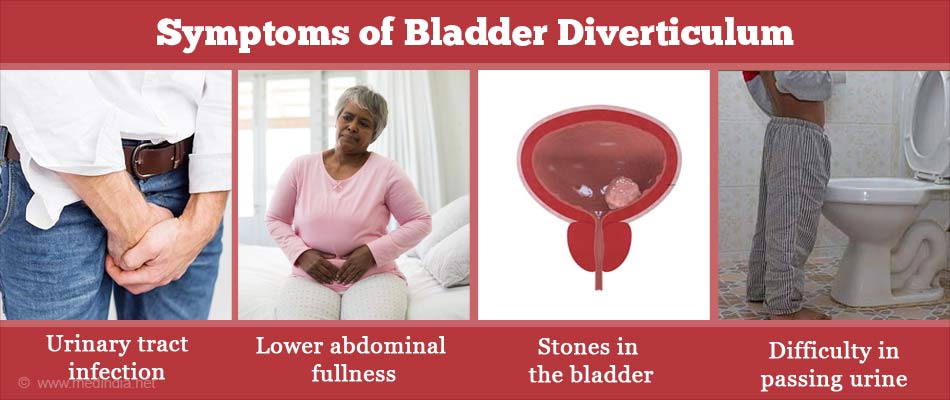- How is a Bladder Diverticulum Treated? - (https://www.urologyhealth.org/urologic-conditions/bladder-diverticulum/treatment)
- Urinary bladder diverticulum - (https://radiopaedia.org/articles/urinary-bladder-diverticulum)
- Robotic Bladder Diverticulectomy - (https://med.nyu.edu/robotic-surgery/physicians/procedures/z-procedures-guide/robotic-bladder-diverticulectomy)
What is Bladder Diverticulum?
Diverticulum (plural diverticula) is the outward bulge of the inner epithelial lining of the bladder through a defect in its muscular layer. It can be present since birth or acquired later in life due to various causes.
There are two peaks of occurrence of diverticula - one presenting at 10 years and the other at 55-70 years
In children it is usually congenital and very often there will only be a single outpouching (diverticulum). In adults it is acquired and there may be several (diverticula). Typically congenital diverticula do not need any treatment whereas the acquired diverticula need specific treatment of the underlying cause.
Structure and Function of Urinary Bladder in Brief
The urinary bladder is the lower part of the urinary tract. The urinary tract consists of the kidney, ureter (the upper urinary tract), the urinary bladder and urethra (lower urinary tract). The urine formed in the kidney travels down the ureter into the bladder, a hollow muscular organ which temporarily stores the urine until the person gets the urge to empty the bladder. The urine is then passed out via the urethral opening.
When viewed under a microscope, the bladder is made up of four layers. From inside to out these are namely the inner mucosal lining of the bladder made up of a special epithelium called transitional epithelium. External to the epithelial layer is the connective tissue layer called the submucosa. Outer to the submucosa is the thick muscle layer of the urinary bladder, which is then covered by the fourth and final layer of peritoneum or serosal layer.

What Causes Bladder Diverticulum?
There may be several causes for bladder diverticula to occur. These include the following
Hutch diverticula - These are outward bulges occurring at the opening of the ureter into the bladder due to a birth defect in the muscle of the bladder. They are seen only in boys.
Bladder neck obstruction – Compression of the bladder neck (junction of the bladder and the urethra), affecting the bladder muscle. This condition is most commonly seen in men over the age of 50 years.
Posterior urethral valves - Also termed congenital obstruction posterior urethral membranes or COPUM and seen only in boys.
Enlarged prostate – Affects men over the age of 50 years with
Ureterocele – The distal end of the ureter balloons out at the point where it enters the bladder. Often associated with two ureters draining the kidney instead of one.
Diamond-Blackfan anemia – Bone marrow disorder leading to anemia. About 50 percent of persons who suffer from this disorder have associated physical abnormalities, including kidney and urethral issues.
Menkes syndrome – Disorder marked by low copper levels in the body. As a result the bladder muscle is weak and tends to bulge outwards under pressure when filled with urine.
Williams syndrome - Developmental condition affecting several different parts of the body. In this condition, body growth and development may be poor with elf-like facial features as well as a degree of mental retardation.

What are the Symptoms of a Bladder Diverticulum?
Very often bladder diverticula do not cause any symptoms and are incidentally detected while investigating urinary symptoms. Diagnosis of bladder diverticula should be suspected in the presence of urinary symptoms in young children or in the setting of prostatic enlargement. Symptoms and signs commonly associated with bladder diverticula include the following:
- Recurrent urinary tract infections due to urine stagnating in the pouch
- Lower abdominal fullness, pain and discomfort
- Stones in the bladder due to urine stagnation in the bladder
- Difficulty passing urine
- Blood in urine
- Pain and fever due to inflammation of the diverticulum – (diverticulitis)
- Urine flowing backwards into the kidneys ("reflux")

How is Bladder Diverticulum Diagnosed?
As mentioned previously bladder diverticula may be found incidentally while investigating the person for urinary symptoms mentioned above with imaging studies such as ultrasound, CT (computerized tomography), MRI (magnetic resonance imaging) and IVU (intravenous urogram). They may appear as ill-defined masses in the pelvis that are difficult to diagnose or interpret on imaging tests.
Cystoscopy - Diverticula may be visualized on cystoscopy wherein a thin flexible tube illuminated at one end is inserted into the urethra and permits the inspection of the interior of the bladder and diagnose specific conditions. Normally the procedure takes around 10-15 minutes
Urodynamic study - A pressure test is performed to see how well the bladder works and check for blocks in the bladder and urethra and to look for urine leaks
Bladder x-ray - Bladder diverticula can be detected on an x-ray test of the bladder. The test is done by filling the bladder with a dye that shows up well in x-rays, (called a "contrast") pictures that will outline the diverticula.
How is Bladder Diverticulum Treated?
- Bladder diverticula may not always cause problems and don’t always require treatment. Usually when treatment is needed it is to manage the underlying cause.
- For example, diverticula caused by a block in the bladder are treated by removing the source of the block and also removal of the diverticula (diverticulectomy). In the case of abnormal growth found in the diverticulum, samples will be taken and tested microscopically for cancer.
- Depending on the cause, open or laparoscopic surgery may be required, in some cases the diverticula may be removed during cystoscopy procedure. A robot may or may not be used to assist with the surgery.
- In those who cannot undergo an open surgery, the diverticulum should be treated by enlarging its opening into the cavity of the bladder
- Treatment is usually effective and the condition does not recur once the primary cause is treated. In some cases periodic monitoring is necessary to look for any recurrence and to monitor proper bladder function.
- In some patients, bladder function may be poor due to long-term obstruction. Such patients may require intermittent catheterization to empty the bladder
- Following bladder diverticulum surgery it is possible the person will need a catheter to drain the bladder for a week or two. This may be uncomfortable, but is necessary.
- Risks with diverticulum surgery include damage to the intestines or ureters, infection, or urine leakage.
A diagnosis of bladder diverticulum may appear daunting, and while the long-term prognosis largely depends on the underlying cause, many urologists agree that early diagnosis and treatment is key to improve patient outcome and quality of life.








